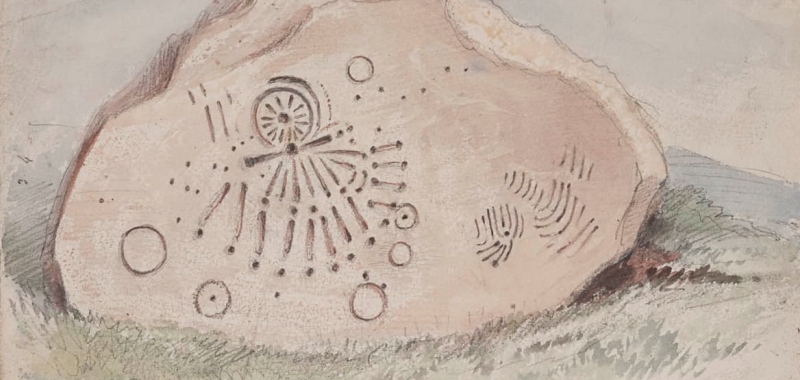George Victor Du Noyer, MRIA, 1817–69
George Victor Du Noyer, MRIA, 1817–69, was born in Dubliln to parents of Huguenot descent. He studied drawing under the tutorship of George Petrie who recognised his exceptional artistic talents and took an interest in his career. By the age of 20 Du Noyer was employed to sketch geological features and archaeological objects in the topographical department of the Ordnance Survey of Ireland. These technical drawings recorded measurements, materials and scale, as stipulated by Petrie, who was in charge of the topographical department.
Du Noyer was also an accomplished botanical artist, known for his technical skill and attention to detail. He worked for a time alongside botanist David Moore (1807–79), who later became director of the National Botanic Gardens in Dublin. Some of his meticulous watercolours depicting botanical specimens are in the library of the National Botanic Gardens in Dublin.
At times when other work was unavailable, Du Noyer worked on book illustration. His sketches were included in Mr & Mrs Hall’s Ireland, its scenery, character, etc., published in 1841–3, and in George Petrie’s long essay on the round towers of Ireland, first published in the Transactions of the Royal Irish Academy in 1845. He later contributed to William Wilde’s catalogue of antiquities in the Royal Irish Academy, a densely illustrated work on which William Wakeman (1822–1900) also worked as an artist.
From 1848 until his early death in 1869 Du Noyer worked with the Geological Survey of Ireland. He trained as a field surveyor and also worked to record geological formations and landscapes. Cartographic work also came within his remit and he was responsible for the geological mapping of four counties (Cork, Kerry, Waterford and Wexford) as well as contributing to others. Many of Du Noyer’s geological drawings, both technical items illustrating geological features and paintings of landscapes and coastlines, are held by the Geological Survey of Ireland and the Geological Survey of Northern Ireland.
Du Noyer presented a large collection of antiquarian sketches to the Royal Irish Academy. These drawings are individually itemised in the Royal Irish Academy online catalogue of Prints and Drawings. Many are large-scale sketches of small architectural details from antiquarian buildings. There is a further collection of bound volumes of his antiquarian sketches in the library of the Royal Society of Antiquaries of Ireland, purchased from his widow after his death. Du Noyer had been elected as a Member of the Royal Irish Academy in 1857 and was made an honorary life member in 1863 following his generous donation of antiquarian sketches.
Further reading
Rob Bohan & Linde Lunney, ‘Du Noyer, George Victor’, in Dictionary of Irish Biography (9 vols, Cambridge, 2009), vol. 3, pp 489–90
Petra Coffey, ‘George Victor Du Noyer, 1817–1869, artist, geologist and antiquary’ Journal of the Royal Society of Antiquaries of Ireland, 123 (1993), pp 102–19
Petra Coffey, ‘DuNoyer, George Victor’, in Nicola Figgis (ed.), Art and Architecture of Ireland, volume II: Painting, 1600–1900 (New Haven: Yale University Press for the Royal Irish Academy and the Paul Mellon Centre, 2014), pp 240–2
Fionnuala Croke (ed.), George Victor Du Noyer, 1817–1869, Hidden landscapes: an exhibition to celebrate the sesquicentennial of the Geological Survey of Ireland [National Gallery of Ireland, Exhibition Catalogue] (Dublin, 1995)
Susan Hegarty, ‘The early days of the Geological Survey in Cork: the all-encompassing pencil of George Victor Du Noyer’, Journal of the Cork Historical & Archaeological Society, 122 (2017), pp 48–62
Susan Hegarty, ‘George Victor Du Noyer’s career in the Ordnance and Geological Surveys (1835–69): geologist by profession, artist by temperament’, Proceedings of the Royal Irish Academy, 118C (2018), pp 271–98 (Available on jstor.org)
Peter Murray (ed.), Stones, slabs and seascapes: George Victor Du Noyer’s images of Ireland [Crawford Art Gallery Exhibition Catalogue] (Cork, 2017)
George Petrie, An inquiry into the origin and uses of the round towers of Ireland, comprising remarks on the ecclesiastical architecture of Ireland, anterior to the Anglo-Norman invasion. Transactions of the Royal Irish Academy, XX (1845). (Available on jstor.org)
M.J.P. Scannell & Christina Houston, ‘George V. du Noyer (1817–1869): a catalogue of plant paintings at the National Botanic Gardens, Glasnevin, with aspects of his scientific life’, Journal of Life Sciences [Royal Dublin Society], 2:1 (1980), pp 1–13.
William Wilde, Descriptive catalogue of the antiquities ... in the museum of the Royal Irish Academy (Dublin, 1862)
Royal Irish Academy online catalogue of Prints and Drawings
BC
June 2020

